|
|
|
Sort Order |
|
|
|
Items / Page
|
|
|
|
|
|
|
| Srl | Item |
| 1 |
ID:
149890
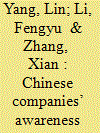

|
|
|
|
|
| Summary/Abstract |
China announced the launch of a national Emissions Trading Scheme (ETS) in 2017; however, companies appear show little enthusiasm for participation in the ETS in China. This paper identifies the factors affecting companies’ awareness and perceptions of ETS by conducting a national survey based on an online questionnaire from May to November 2015 in seven carbon trading pilots. The results indicate that companies’ attitudes towards the ETS are positively influenced by government regulations and policy, public relations management and estimated economic benefit. Of these, public relations management is the decisive factor and estimated economic benefit is confirmed to be a relatively weak predictor. A company's environmental and energy strategy exerts insignificant effects on its preference for the ETS, although the sampled companies are very willing to save energy and reduce emissions. There exists an inverted U-shape relationship between a company's level of mitigation technologies and its attitudes towards the ETS. The carbon price fails to stimulate companies to upgrade mitigation technologies. The majority of companies treat participation in the ETS only as a means of improving ties with governments, as well as of earning a good social reputation, rather than as a cost-effective mechanism to mitigate greenhouse gas emissions.
|
|
|
|
|
|
|
|
|
|
|
|
|
|
|
|
| 2 |
ID:
136193


|
|
|
|
|
| Summary/Abstract |
We assess recent Chinese climate policy proposals in a multi-region, multi-sector computable general equilibrium model with a Chinese carbon emissions trading scheme (ETS). When the emissions intensity per GDP in 2020 is required to be 45% lower than in 2005, the model simulations indicate that the climate policy induced welfare loss in 2020, measured as the level of GDP and welfare in 2020 under climate policy relative to their level under business-as-usual (BAU) in the same year, is about 1%. The Chinese welfare loss in 2020 slightly increases in the Chinese rate of economic growth in 2020. When keeping the emissions target fixed at the 2020 level after 2020 in absolute terms, the welfare loss will reach about 2% in 2030. If China׳s annual economic growth rate is 0.5 percentage points higher (lower), the climate policy-induced welfare loss in 2030 will rise (decline) by about 0.5 percentage points. Full auctioning of carbon allowances results in very similar macroeconomic effects as free allocation, but full auctioning leads to higher reductions in output than free allocation for ETS sectors. Linking the Chinese to the European ETS and restricting the transfer volume to one third of the EU׳s reduction effort creates at best a small benefit for China, yet with smaller sectoral output reductions than auctioning. These results highlight the importance of designing the Chinese ETS wisely.
|
|
|
|
|
|
|
|
|
|
|
|
|
|
|
|
| 3 |
ID:
091564
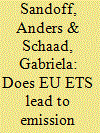

|
|
|
|
|
| Publication |
2009.
|
| Summary/Abstract |
The first trading period of the European Emissions Trading Scheme (EU ETS) has recently come to an end. The experiences of the actors in the trading sector will be of great importance in evaluating the aim and direction of this "Grand Policy Experiment". This paper gives an account of the attitudes and actions of the companies included in the Swedish emissions trading sector after about 15 months of experience with the system. The data are based on a study commissioned by the Swedish Environmental Protection Agency, and is a comprehensive survey that encompasses all companies operating installations included in the Swedish Emission Trading Registry. However, the results point in a somewhat disquieting direction. Although the Swedish companies have shown significant interest in reducing emissions, this survey indicates that this is done without close attention to the pricing mechanism of the market-based instruments. If this praxis is widespread within the European trading sector, it can have a serious negative effect on the efficiency of the system.
|
|
|
|
|
|
|
|
|
|
|
|
|
|
|
|
| 4 |
ID:
136192
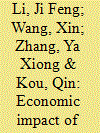

|
|
|
|
|
| Summary/Abstract |
We use a dynamic CGE model (SICGE) to assess the economic and climate impacts of emissions trading system (ETS) in China with a carbon price of 100 Yuan/ton CO2. A particular focus is given to the regulated electricity price regime, which is a major concern of electricity sector’s cost-effective participation in ETS in China. We found: (1) Carbon pricing is an effective policy for China to reduce CO2 emissions. Total CO2 emissions reduction ranges from 6.8% to 11.2% in short-term. (2) Rigid electricity price entails lower CO2 emissions reduction but can be considered as a feasible starting point to introduce carbon pricing policies in short-term as long as governmental subsidies are given to electricity production. (3) In mid- and long-term, the efficient policy is to earmark carbon revenue with competitive electricity price. We propose to use carbon revenue to reduce consumption tax in the first year of the introduction of carbon price and to use the carbon revenue to reduce production tax in following years.
|
|
|
|
|
|
|
|
|
|
|
|
|
|
|
|
| 5 |
ID:
176845
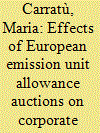

|
|
|
|
|
| Summary/Abstract |
During Phase 3 of the EU Emission Trading System (ETS), to remedy the so-called windfall profits obtained by companies that benefited from the free allocation of emission permits, the EU introduced an auction-based method for the allocation of carbon emission allowances. We estimate the effect on firms' profits from participating in auctions during Phase 3 of the EU ETS using a propensity score matching approach. The work shows that the introduction of the new market mechanism for allocating carbon emission allowances has no significant effect on corporate profits, whatever the measure of profitability used. From a policy standpoint, this result seems to suggest that this new allocation mechanism might fail to improve the incentives for companies to increase their production cost efficiency or to invest in breakthrough technologies that reduce CO2. The rather flat auction price trend seems to support this conclusion.
|
|
|
|
|
|
|
|
|
|
|
|
|
|
|
|
| 6 |
ID:
176797


|
|
|
|
|
| Summary/Abstract |
How much carbon is in the price of power? The answer to this question determines many economic consequences of climate policies, i.e. in terms of costs for downstream industries. It requires, however, to first identify the cost impact of carbon pricing on the price-setting entity on the power market. Economic theory tells us that power prices are determined by the cost of the marginal plant. We propose two simple approaches to conclude on marginal technologies in electricity wholesale from public data. Both approaches are complementary, easy to implement, and based upon assumptions which are commonly used in more complex energy system models. We exemplify their use with a policy example on the compensation for indirect emission costs from the EU Emissions Trading Scheme. We find that the current policy design severely overweighs CO emissions from lignite power plants in the Central Western European power market, which may lead to overcompensation of industrial power users and therefore to a distortion with regard to the policy’s stated goal.
|
|
|
|
|
|
|
|
|
|
|
|
|
|
|
|
| 7 |
ID:
166396
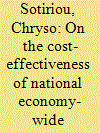

|
|
|
|
|
| Summary/Abstract |
This paper explores cost-effective greenhouse gas abatement options for the European Union Member State of Cyprus, for those sectors of the national economy that are not subject to the European Emissions Trading System. The analysis leads to the construction of a baseline and several alternative marginal emission abatement cost curves. It addresses all economic sectors and considers all different types of mitigation measures – improving energy efficiency, switching to low- or zero-carbon fuels, and inducing behavioural change towards public transport modes. We apply nationally appropriate data that are mainly derived from local market information and judgement of national experts. Finally, we present results of several sensitivity analyses, which address main shortcomings of marginal abatement cost curves that have been identified in the literature, and discuss the policy implications of each one of them. Apart from its relevance for EU Member States, this assessment is useful for all countries seeking guidance in their decarbonisation strategies.
|
|
|
|
|
|
|
|
|
|
|
|
|
|
|
|
| 8 |
ID:
138919


|
|
|
|
|
| Summary/Abstract |
In 2008, the European Union (EU) decided to include aviation in its Emissions Trading System (ETS) in order to realize emissions reductions in the aviation sector. However, the unilateral measure has triggered strong opposition from various actors, and now, the EU finds itself in the middle of a substantial power struggle about the creation of a global scheme for international aviation emissions reduction. China plays an important role as it has not only banned its airlines from complying with the EU ETS, but also implemented economic retaliatory measures, such as freezing orders of new European Airbus aircraft. Consequently, Beijing could successfully form coalitions with other countries to dilute international negotiations at the International Civil Aviation Organization (ICAO) assembly in 2013. The study reveals the hardships that the establishment of a global carbon emissions reduction scheme for aviation faces. It discusses the leading role of the EU on the issue, and provides a general assessment of possible responses to the aviation directive. It then analyzes China’s position on the inclusion of aviation under a global carbon reduction scheme. Finally, the study provides a prospect on how to overcome the diplomatic struggle in order to achieve concrete carbon emission reductions in aviation. As the study concludes, the EU and the rest of the world would be better off by refraining from unilateral mitigation measures and emphasizing more involvement, engagement, and capacity building in negotiating a possible carbon reduction scheme at the international level.
|
|
|
|
|
|
|
|
|
|
|
|
|
|
|
|
| 9 |
ID:
150680


|
|
|
|
|
| Summary/Abstract |
The European Commission discusses the change of free allocation plans to guarantee a stable market equilibrium. Selling over-allocated contracts effectively depreciates prices and negates the effect intended by the regulator to establish a stable price mechanism for CO2 assets. Our paper investigates mispricing and allocation issues by quantitatively analyzing variance risk premia of CO2 markets over the course of changing regimes (Phase I-III) for three different assets (European Union Allowances, Certified Emissions Reductions and European Reduction Units). The research paper gives recommendations to regulatory bodies in order to most effectively cap the overall carbon dioxide emissions.
|
|
|
|
|
|
|
|
|
|
|
|
|
|
|
|
|
|
|
|
|